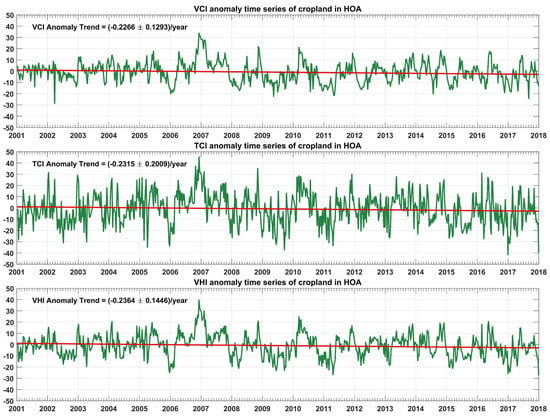Monitoring Extreme Agricultural Drought over the Horn of Africa (HOA) Using Remote Sensing Measurements
Abstract
1. Introduction
2. Data and Methods
2.1. Study Area and Data
- Terra MODIS 8-day surface reflectance data (MOD09). The MOD09 products provide an estimate of surface reflectance at 500 m spatial resolution during an 8-day period based on the best possible observations;
- Terra Land Surface Temperature/Emissivity 8-Day L3 Global 1km (MOD11). MOD11 data products contain day and nighttime land surface temperatures at 1 km spatial resolution, as well as emissivity. Daytime land surface temperature data were used in this study;
- Terra/Aqua MODIS land cover type data (MCD12). MCD12 products provide data on global land cover type assessments and quality control information at 500 m spatial resolution.
2.2. Data Processing and Analysis
2.2.1. Land Cover Types
2.2.2. MODIS Vegetation Indices
- (1)
- For each 8-day period during year 2000–2017, use the MODIS Reprojection Tool (MRT) to reproject and resample MODIS surface reflectance data to the study area at 500 m spatial resolution, and then calculate the NDVI based on Equation (1);
- (2)
- For each 8-day period during years 2000–2017, use the MODIS Reprojection Tool (MRT) to reproject and resample MODIS land surface temperature data (LST) to the study area at 500 m resolution;
- (3)
- For the study area, use the 2001–2010 10-year data to calculate the maximum and minimum values of NDVI (NDVImax and NDVImin) and the maximum and minimum values of land surface temperature (LSTmax and LSTmin) for each pixel and each 8-day period;
- (4)
- For each 8-day period during years 2000–2017, calculate the VCI using Equation (2);
- (5)
- For each 8-day period during years 2000–2017, calculate the TCI using Equation (3);
- (6)
- Calculate the VHI using Equation (4) with VCI and TCI data;
- (7)
- Use the 10 years from 2001 to 2010 as normal to get VCI, TCI, and VHI climatology for each of the 8-day periods;
- (8)
- Generate 8-day VCI anomaly, TCI anomaly, and VHI anomaly data at 1 km spatial resolution and 8-day temporal resolution by subtracting VCI, TCI, and VHI data from corresponding climatology;
- (9)
- In addition, reproject and sample MODIS land cover type data over the study area at the same resolution (500 m) with the VCI, TCI, and VHI. The land cover type data are used to generate a spatial mask of the agricultural area for analysis of the VCI, TCI, and VHI;
- (10)
- Subset VCI, TCI, and VHI anomaly data using the mask for the agricultural area generated in step 9, and then conduct a spatial and temporal analysis.
2.2.3. Rainfall Data
- (1)
- Generate a spatial mask at 0.25° spatial resolution for HOA;
- (2)
- Subset the TRMM 3B43 monthly rainfall data from years 1998 and 2017 to the HOA area;
- (3)
- Generate precipitation climatology using the data from years 2001–2010, and then get monthly anomalies of precipitations in the HOA;
- (4)
- Analyze the spatial patterns and temporal trends of precipitation during crop growth seasons.
3. Results
3.1. The 2015–2016 Extreme Drought Event in the HOA
3.2. Temporal Trends of Rainfall and Vegetation Indices in Crop Growing Season
3.3. Rainfall and Crop Status in the Growth Season
4. Discussion
5. Conclusions
Author Contributions
Funding
Acknowledgments
Conflicts of Interest
References
- UN Aid Chief Urges Global Action as Starvation, Famine Loom for 20 Million across Four Countries. Available online: https://news.un.org/en/story/2017/03/553152-un-aid-chief-urges-global-action-starvation-famine-loom-20-million-across-four#.WbVBQ9GQxdh (accessed on 8 May 2018).
- Townshend, J.R.G.; Justice, C. Towards operational monitoring of terrestrial systems by moderate-resolution remote sensing. Remote Sens. Environ. 2002, 83, 351–359. [Google Scholar] [CrossRef]
- Tucker, C.J. Red and photographic infrared linear combinations for monitoring vegetation. Remote Sens. Environ. 1979, 8, 127–150. [Google Scholar] [CrossRef]
- Anyamba, A.; Tucker, C.J. Historical perspective of AVHRR NDVI and vegetation drought monitoring. In Remote Sensing of Drought: Innovative Monitoring Approaches; Wardlow, D.B., Anderson, C.M., Verdin, P.J., Eds.; Taylor & Francis: Milton Park, UK, 2012; pp. 23–50. [Google Scholar]
- Kogan, F.N. Application of vegetation index and brightness temperature for drought detection. Adv. Space Res. 1995, 15, 91–100. [Google Scholar] [CrossRef]
- Kogan, F.N. Droughts of the late 1980s in the United States as derived from NOAA Polar–Orbiting Satellite Data. Bull. Am. Meteorol. Soc. 1995, 76, 655–668. [Google Scholar] [CrossRef]
- Liu, W.T.; Kogan, F.N. Monitoring regional drought using the Vegetation Condition Index. Int. J. Remote Sens. 1996, 17, 2761–2782. [Google Scholar] [CrossRef]
- Kogan, F.N. Global drought watch from space. Bull. Am. Meteorol. Soc. 1997, 78, 621–636. [Google Scholar] [CrossRef]
- Unganai, L.S.; Kogan, F.N. Drought monitoring and corn yield estimation in Southern Africa from AVHRR data. Remote Sens. Environ. 1998, 63, 219–232. [Google Scholar] [CrossRef]
- Awange, J.L.; Schumacher, M.; Forootan, E.; Heck, B. Exploring hydro-meteorological drought patterns over the Greater Horn of Africa (1979–2014) using remote sensing and reanalysis products. Adv. Water Resour. 2016, 94, 45–59. [Google Scholar] [CrossRef]
- Jiao, W.Z.; Zhang, L.F.; Chang, Q.; Fu, D.J.; Cen, Y.; Tong, Q.X. Evaluating an Enhanced Vegetation Condition Index (VCI) Based on VIUPD for Drought Monitoring in the Continental United States. Remote Sen. 2016, 8, 224. [Google Scholar] [CrossRef]
- Choi, T.; Qu, J.J.; Xiong, X. A thirteen-year analysis of drought in the Horn of Africa with MODIS NDVI and NWDI measurements. In Proceedings of the 2nd International Conference on Agro-Geoinformatics, Fairfax, VA, USA, 12–16 August 2013. [Google Scholar]
- Wu, D.; Qu, J.J.; Hao, X. Agricultural drought monitoring using MODIS based drought indices over the Corn Belt. Int. J. Remote Sens. 2015, 36, 5403–5425. [Google Scholar] [CrossRef]
- Wu, D. An Investigation of Agriculture Drought on the United States Corn Belt Using Satellite Remote Sensing and GIS Technology. Ph.D. Thesis, George Mason University, Fairfax, VA, USA, May 2014. Available online: http://hdl.handle.net/1920/8897 (accessed on 10 July 2018).
- Brown, M.E.; Funk, C.C.; Galu, G.; Choularton, R. Earlier Famine Warning Possible Using Remote Sensing and Models. Eos. Trans. AGU 2007, 88, 381–382. [Google Scholar] [CrossRef]
- Brown, M.E. Remote Sensing Technology and Land Use Analysis in Food Security Assessment. J. Land Use Sci. 2016, 11, 623–641. [Google Scholar] [CrossRef]
- Klisch, A.; Atzberger, C. Operational Drought Monitoring in Kenya Using MODIS NDVI Time Series. Remote Sens. 2016, 8, 267. [Google Scholar] [CrossRef]
- Enenkel, M.; Steiner, C.; Mistelbauer, T.; Dorigo, W.; Wagner, W.; See, L.; Atzberger, C.; Schneider, S.; Rogenhofer, E. A Combined Satellite-Derived Drought Indicator to Support Humanitarian Aid Organizations. Remote Sens. 2016, 8, 340. [Google Scholar] [CrossRef]
- Palmer, W.C. Meteorological drought. In Weather Bureau Research Paper; US Department of Commerce: Washington, DC, USA, 1965; No. 55, 58. [Google Scholar]
- McKee, T.B.; Doesken, N.J.; Kleist, J. The relationship of drought frequency and duration to time scales. In Proceedings of the 8th Conference on Applied Climatology, Anaheim, CA, USA, 17–22 January 1993. [Google Scholar]
- Svoboda, M.D.; LeComte, D.; Hayes, M.J. The Drought Monitor. Bull. Am. Meteorol. Soc. 2002, 93, 1181–1190. [Google Scholar] [CrossRef]
- Zargar, A.; Sadiq, R.; Naser, B.; Khan, F.I. A review of drought indices. Environ. Rev. 2011, 19, 333–349. [Google Scholar] [CrossRef]
- Duan, Z.; Bastiaanssen, W. First results from Version 7 TRMM 3B43 precipitation product in combination with a new downscaling–Calibration procedure. Remote Sens. Environ. 2013, 131, 1–13. [Google Scholar] [CrossRef]
- Hafner, J.; DeCarlo, S. Monthly 0.25° × 0.25° TRMM multi-satellite and other sources rainfall (3B43). Available online: http://apdrc.soest.hawaii.edu/datadoc/trmm_3b43.php (accessed on 8 July 2018).
- Tierney, J.E.; Ummenhofer, C.C.; deMenocal, P.B. Past and future rainfall in the Horn of Africa. Sci. Adv. 2015, 1, e1500682. [Google Scholar] [CrossRef]
- The Food and Agriculture Organization Corporate Statistical Database (FAOSTAT). Available online: http://www.fao.org/faostat/en/#home (accessed on 2 March 2019).
- Food and Agriculture Organization (FAO) of the United Nations. Crop Calendar–An Information Tool for Seed Security. Available online: http://www.fao.org/agriculture/seed/cropcalendar/searchbycountry.do (accessed on 8 May 2018).
- NASA Earth Science Data. Available online: https://earthdata.nasa.gov/ (accessed on 20 June 2018).
- Pérez-Hoyos, A.; Rembold, F.; Kerdiles, H.; Gallego, J. Comparison of Global Land Cover Datasets for Cropland Monitoring. Remote Sens. 2017, 9, 1118. [Google Scholar] [CrossRef]
- Meroni, M.; Atzberger, C.; Vancutsem, C.; Gobron, N.; Baret, F.; Lacaze, R.; Eerens, H.; Leo, O. Evaluation of Agreement Between Space Remote Sensing SPOT-VEGETATION fAPAR Time Series. IEEE Trans. Geosci. Remote Sens. 2013, 51, 1951–1962. [Google Scholar] [CrossRef]
- Atkinson, P.M.; Jeganathan, C.; Dash, J.; Atzberger, C. Intercomparison of four models for smoothing satellite sensor time-series data to estimate vegetation phenology. Remote Sens. Environ. 2012, 123, 400–417. [Google Scholar] [CrossRef]
- Mohammed, Y.; Yimer, F.; Tadesse, M.; Tesfaye, K. Meteorological drought assessment in north east highlands of Ethiopia. Int. J. Clim. Chang. Strateg. 2018, 10, 142–160. [Google Scholar] [CrossRef]
- United States Climate Prediction Center. Cold & Warm Episodes by Season. Available online: https://origin.cpc.ncep.noaa.gov/products/analysis_monitoring/ensostuff/ONI_v5.php (accessed on 20 February 2019).
- Tarnavsky, E.; Grimes, D.; Maidment, R.; Black, E.; Allan, R.P.; Stringer, M.; Chadwick, R.; Kayitakire, F. Extension of the TAMSAT satellite-based rainfall monitoring over Africa and from 1983 to present. J. Appl. Meteorol. Climatol. 2014, 53, 2805–2822. [Google Scholar] [CrossRef]
- Maidment, R.I.; Grimes, D.; Allan, R.P.; Tarnavsky, E.; Stringer, M.; Hewison, T.; Roebeling, R.; Black, E. The 30 year TAMSAT African rainfall climatology and time series (TARCAT) data set. J. Geophys. Res. Atmos. 2014, 119, 10619–10644. [Google Scholar] [CrossRef]
- Funk, C.C.; Peterson, P.J.; Landsfeld, M.F.; Pedreros, D.H.; Verdin, J.P.; Rowland, J.D.; Romero, B.E.; Husak, G.J.; Michaelsen, J.C.; Verdin, A.P. A Quasi-Global Precipitation Time Series for Drought Monitoring. In U.S. Geological Survey Data Series 832; US Geological Survey: Reston, VA, USA, 2014; 4p. [Google Scholar]
- Joyce, R.J.; Janowiak, J.E.; Arkin, P.A.; Xie, P.P. Cmorph: A method that produces global precipitation estimates from passive microwave and infrared data at high spatial and temporal resolution. J. Hydrometeorol. 2004, 5, 487–503. [Google Scholar] [CrossRef]
- Ashouri, H.; Hsu, K.L.; Sorooshian, S.; Braithwaite, D.K.; Knapp, K.R.; Cecil, L.D.; Nelson, B.R.; Prat, O.P. PERSIANN-CDR daily precipitation climate data record from multisatellite observations for hydrological and climate studies. Bull. Am. Meteorol. Soc. 2015, 96, 69–83. [Google Scholar] [CrossRef]
- Xie, P.; Arkin, P.A. Global monthly precipitation estimates from satellite-observed outgoing longwave radiation. J. Clim. 1997, 11, 137–164. [Google Scholar] [CrossRef]
- Adler, R.F.; Huffman, G.J.; Chang, A.; Ferraro, R.; Xie, P.; Janowiak, J.; Arkin, P. The version 2 global precipitation climatology project (GPCP) monthly precipitation analysis. J. Hydrometeorol. 2003, 4, 1147–1167. [Google Scholar] [CrossRef]
- Kimani, M.W.; Hoedjes, J.C.B.; Su, Z. An Assessment of Satellite-Derived Rainfall Products Relative to Ground Observations over East Africa. Remote Sens. 2017, 9, 430. [Google Scholar] [CrossRef]
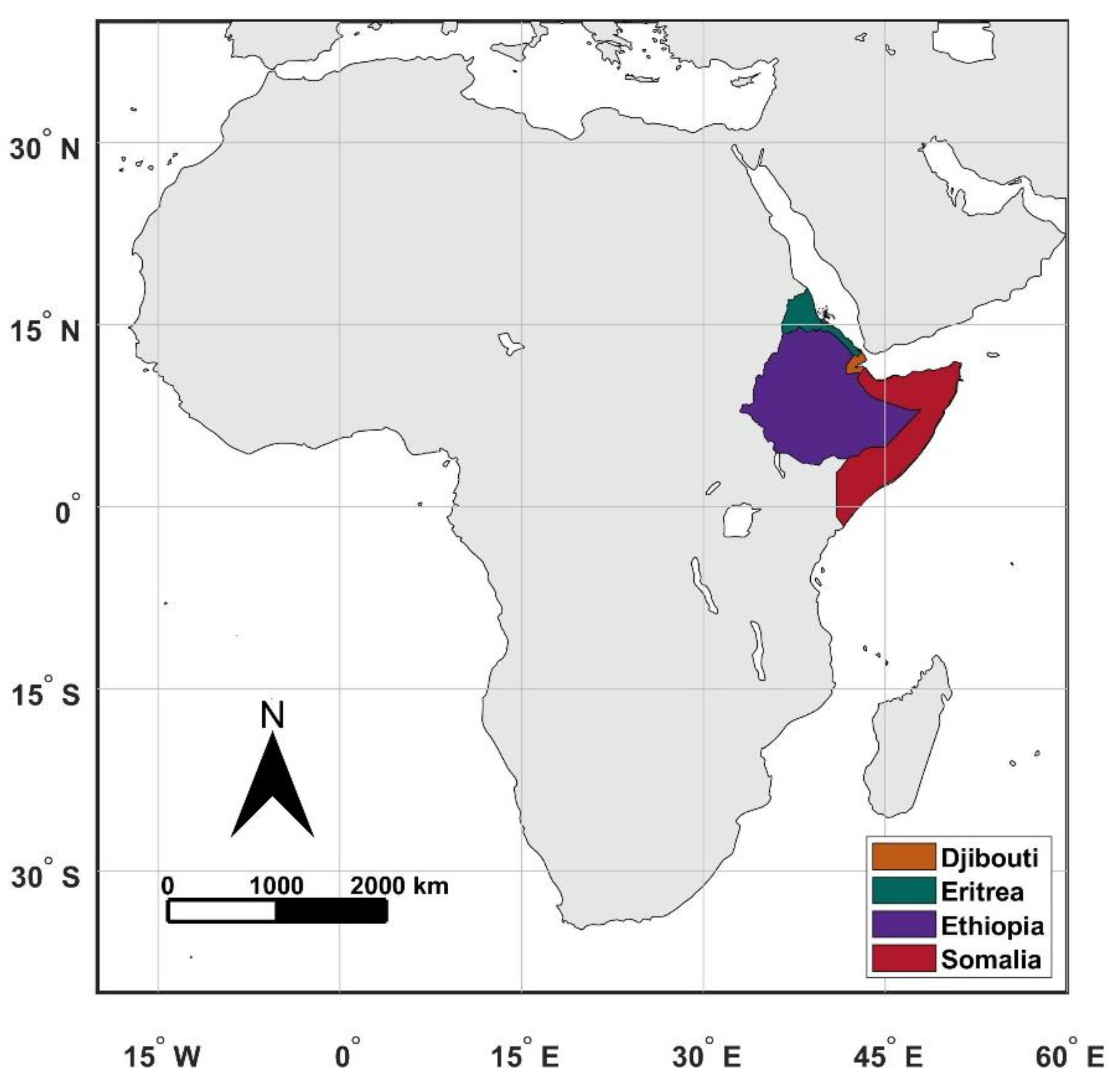
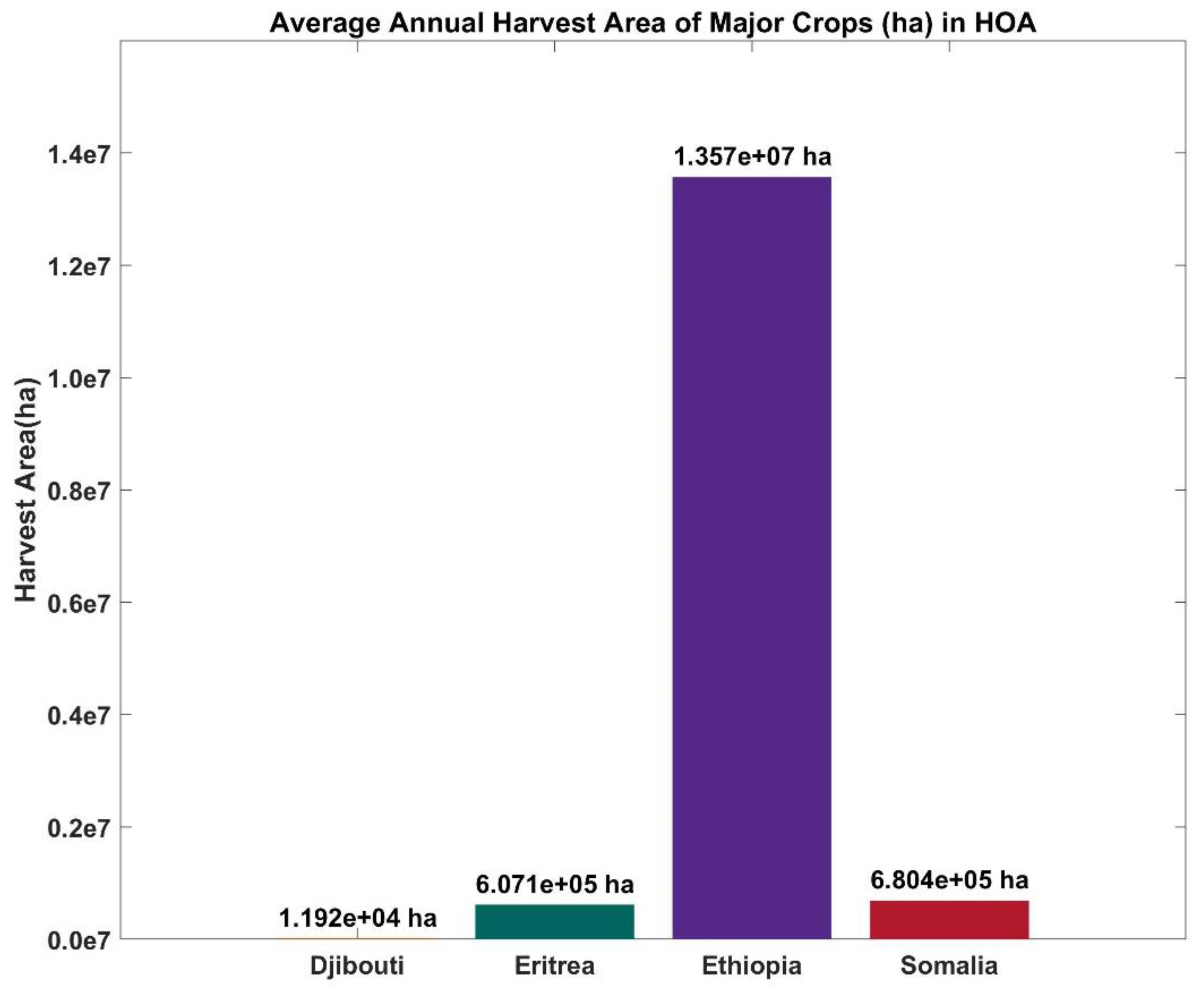
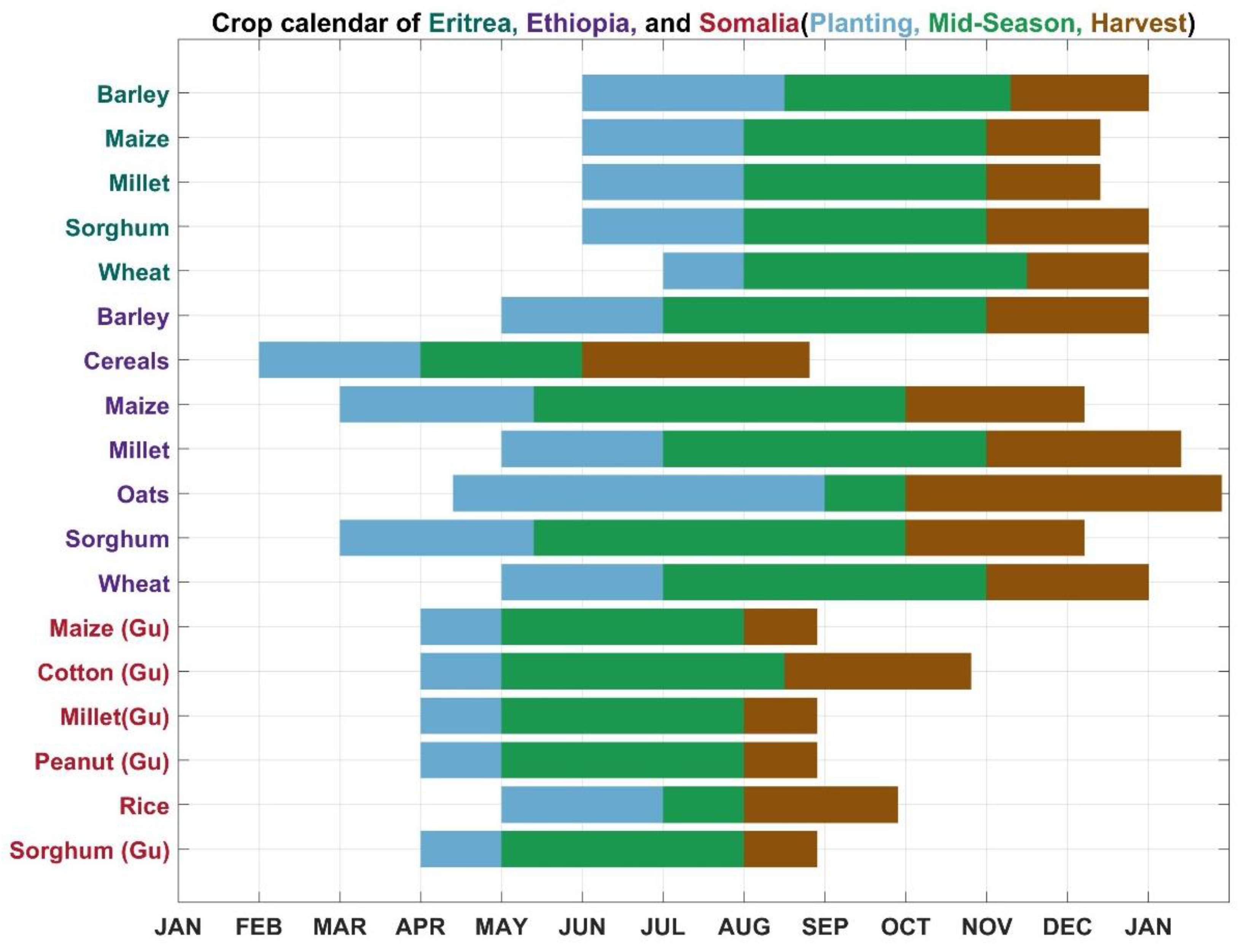
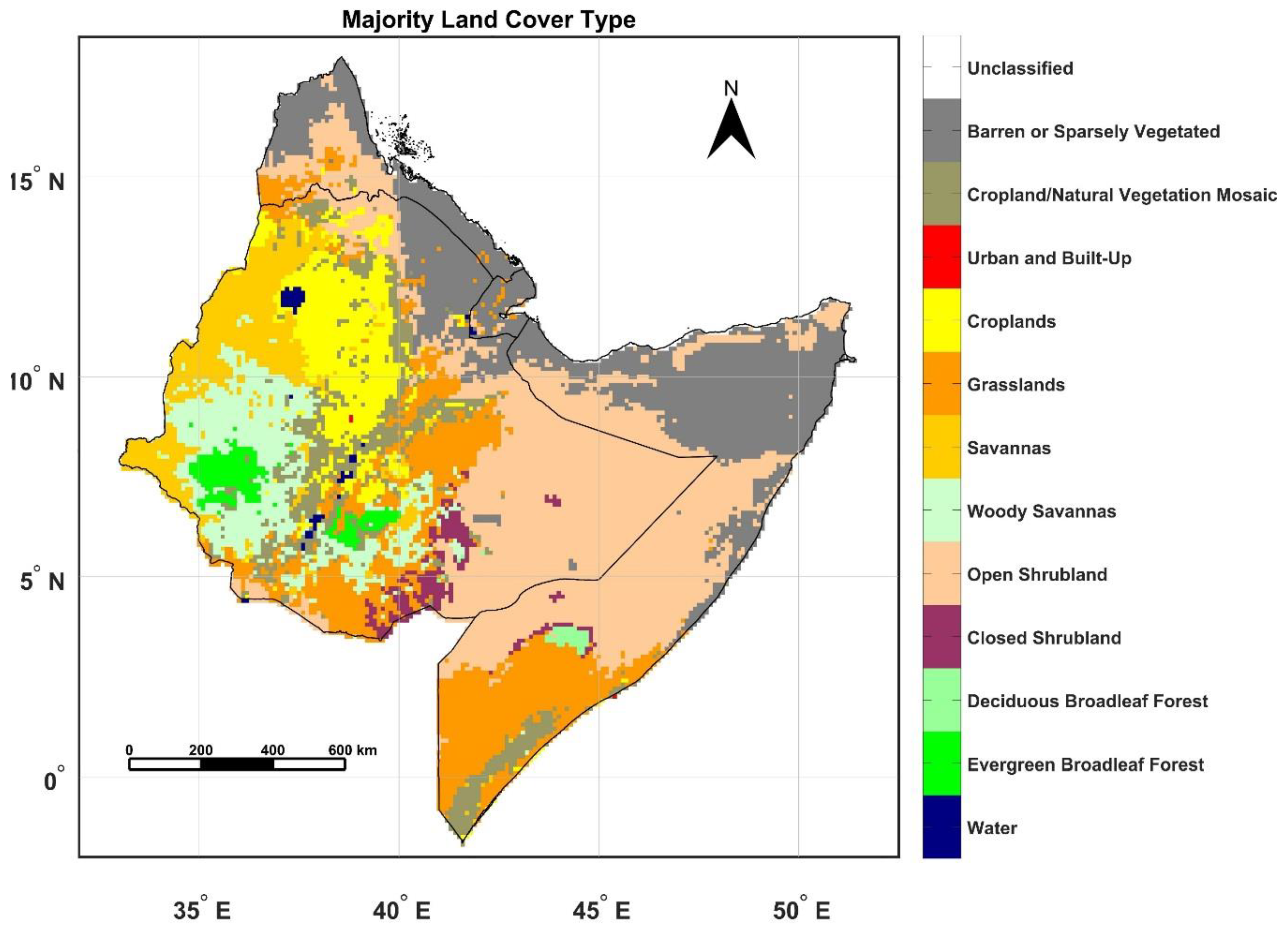
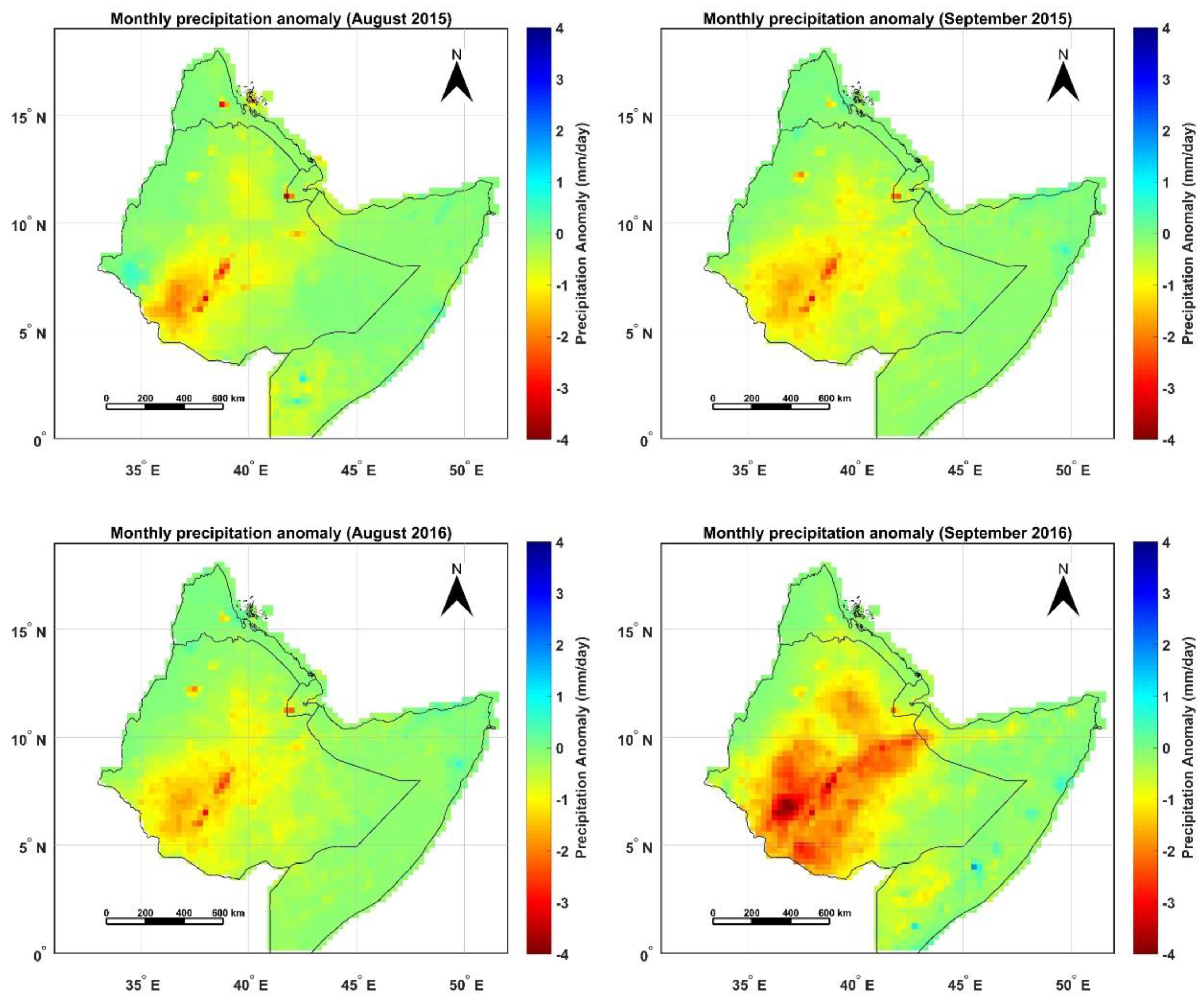
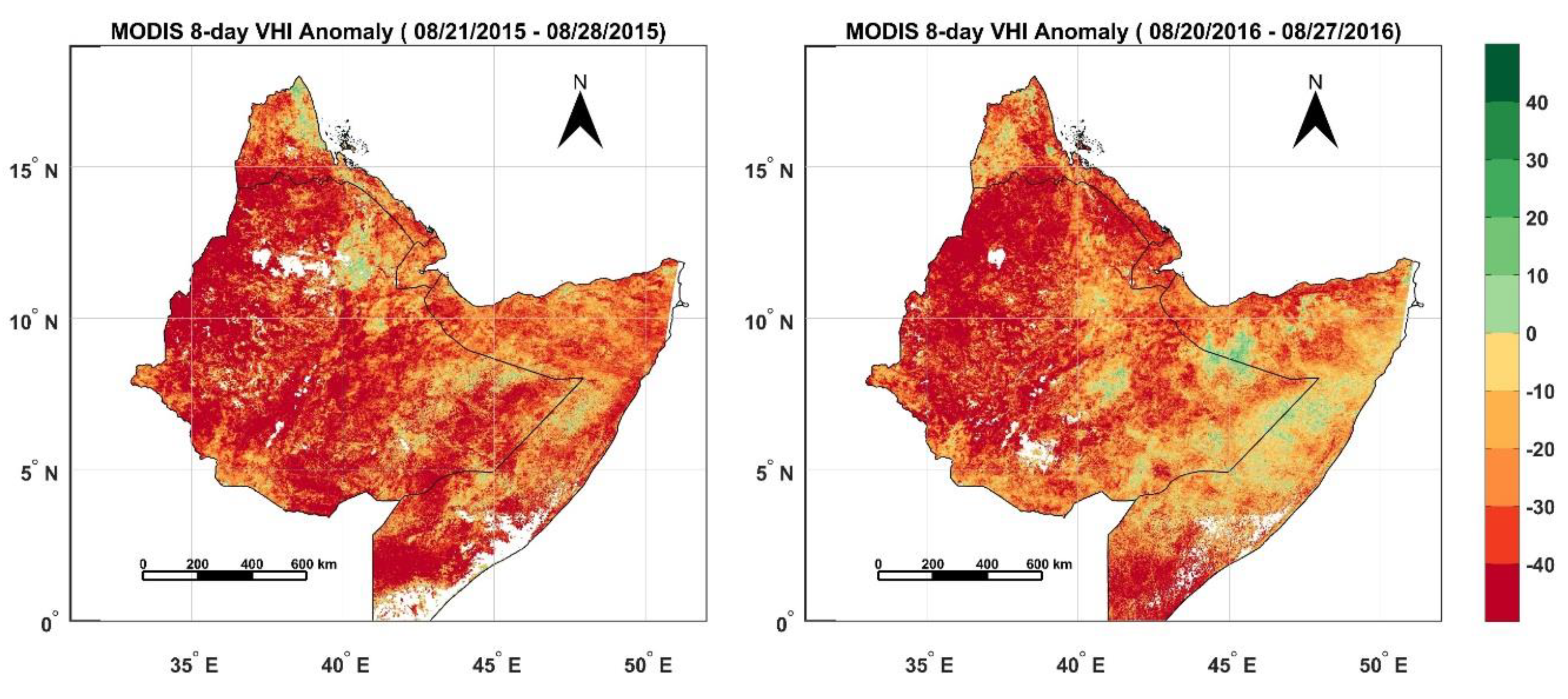
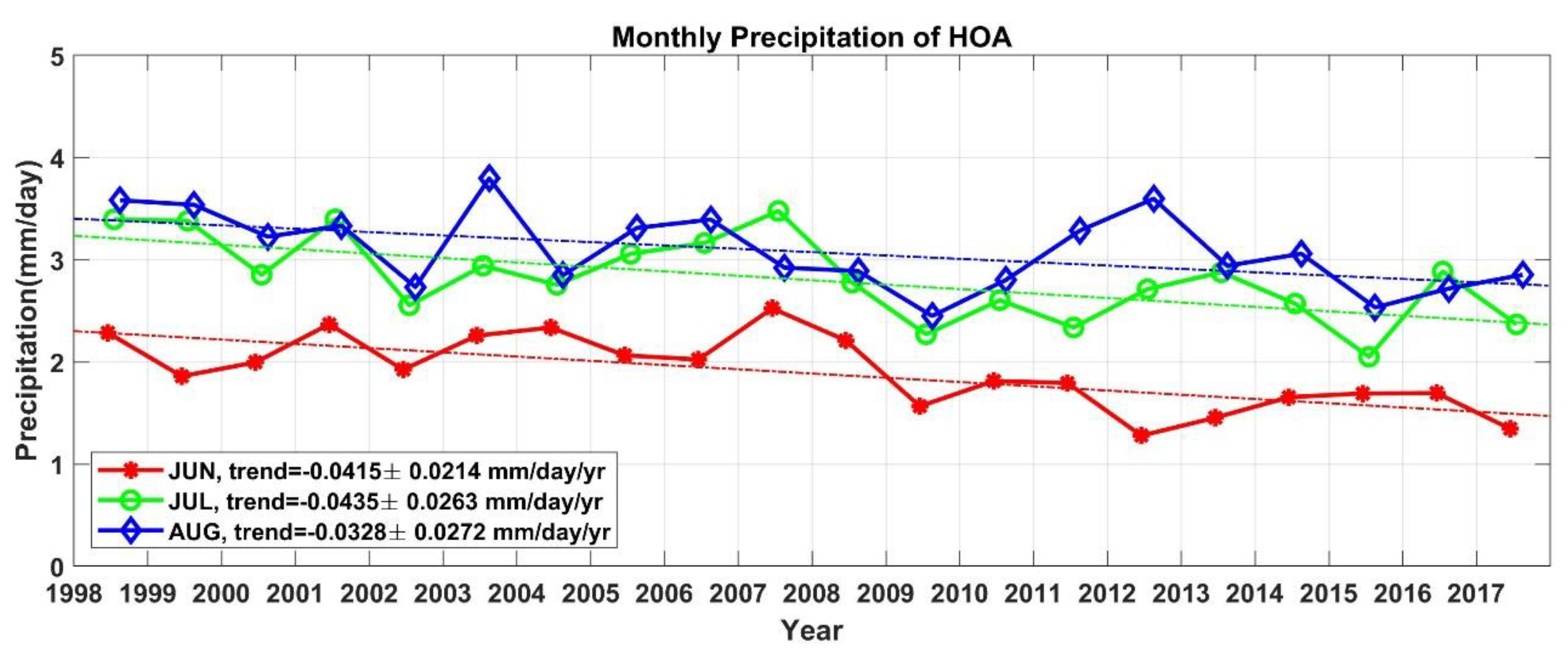
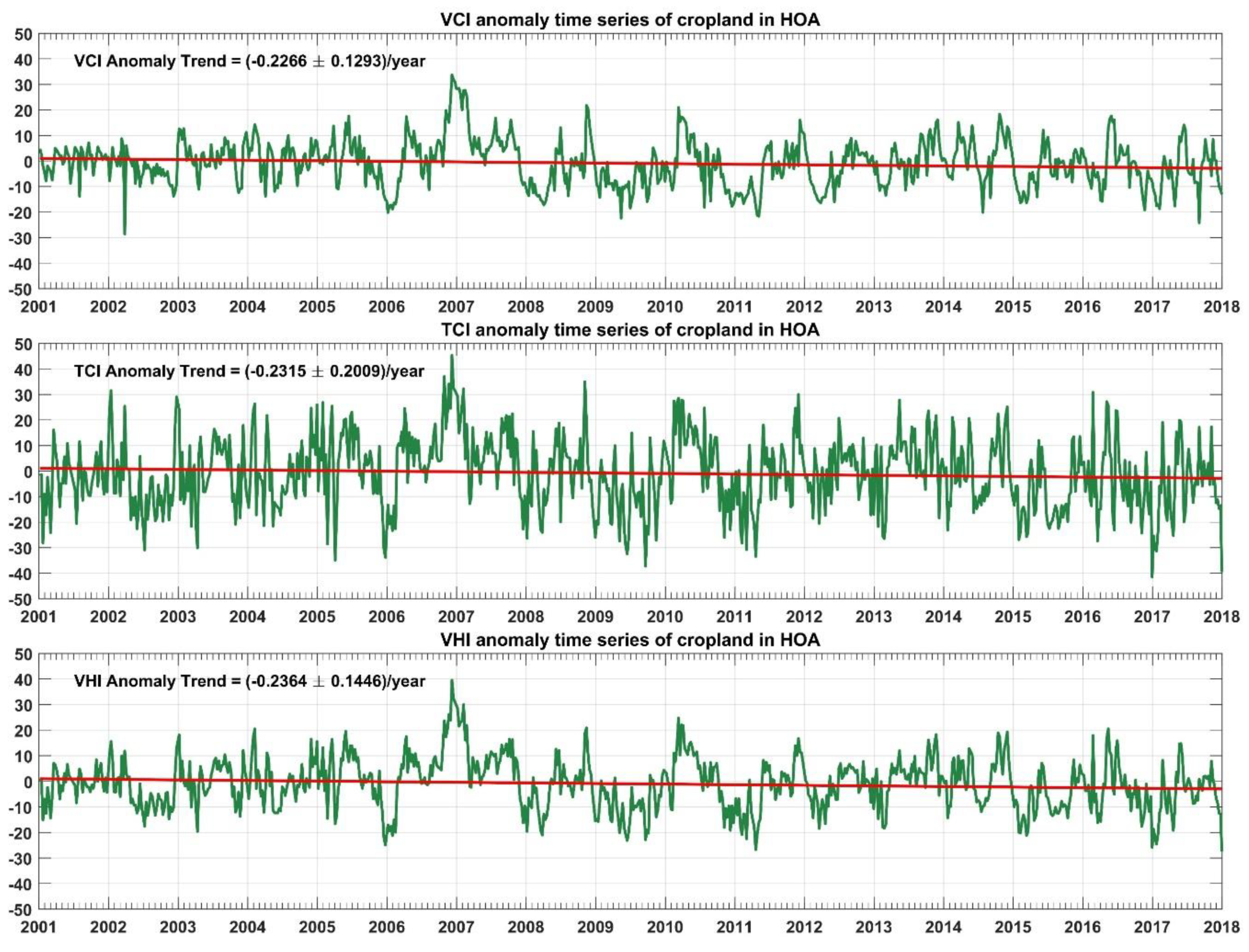
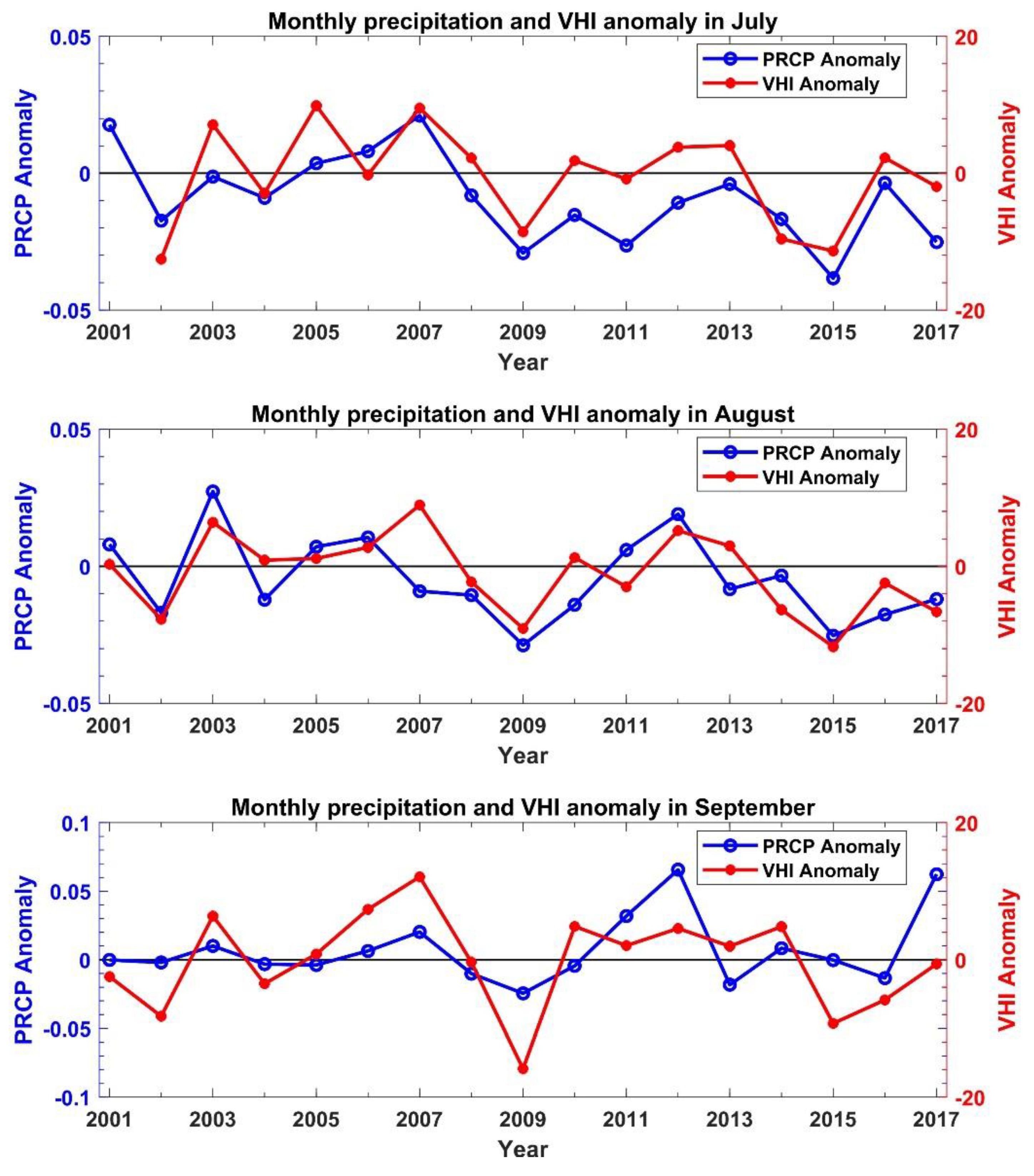
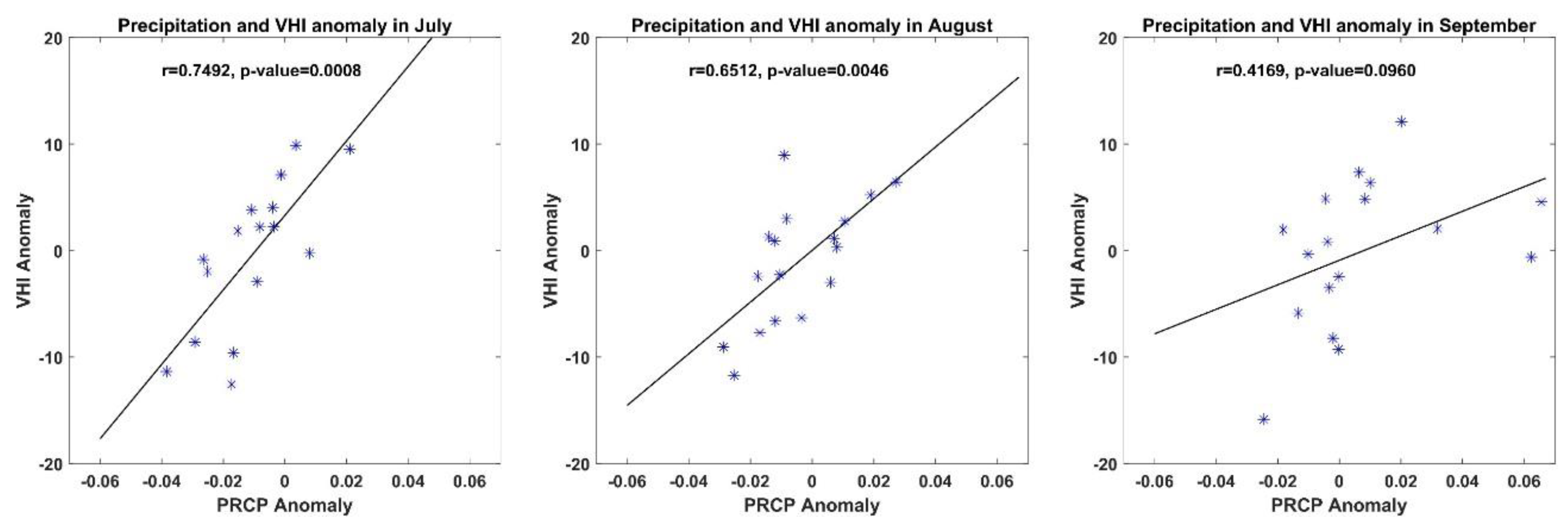
| Month | Trend | Trend Confidence Interval (95% Level) | p-Value |
|---|---|---|---|
| June | −0.0415 mm/day/year | [−0.0630, −0.0201] mm/day/year | 7.1941 × 10−4 |
| July | −0.0435 mm/day/year | [−0.0698, −0.0172] mm/day/year | 0.0027 |
| August | −0.0328 mm/day/year | [−0.0600, −0.0055] mm/day/year | 0.0211 |
| Index Anomaly | Trend | Trend Confidence Interval (95% Level) | p-Value |
|---|---|---|---|
| VCI Anomaly | −0.2266/year | [−0.3559, −0.0973]/year | 0.0006 |
| TCI Anomaly | −0.2315/year | [−0.4325, −0.0306]/year | 0.0240 |
| VHI Anomaly | −0.2364/year | [−0.3810, −0.0918]/year | 0.0014 |
© 2019 by the authors. Licensee MDPI, Basel, Switzerland. This article is an open access article distributed under the terms and conditions of the Creative Commons Attribution (CC BY) license (http://creativecommons.org/licenses/by/4.0/).
Share and Cite
Qu, C.; Hao, X.; Qu, J.J. Monitoring Extreme Agricultural Drought over the Horn of Africa (HOA) Using Remote Sensing Measurements. Remote Sens. 2019, 11, 902. https://doi.org/10.3390/rs11080902
Qu C, Hao X, Qu JJ. Monitoring Extreme Agricultural Drought over the Horn of Africa (HOA) Using Remote Sensing Measurements. Remote Sensing. 2019; 11(8):902. https://doi.org/10.3390/rs11080902
Chicago/Turabian StyleQu, Carolyn, Xianjun Hao, and John J. Qu. 2019. "Monitoring Extreme Agricultural Drought over the Horn of Africa (HOA) Using Remote Sensing Measurements" Remote Sensing 11, no. 8: 902. https://doi.org/10.3390/rs11080902
APA StyleQu, C., Hao, X., & Qu, J. J. (2019). Monitoring Extreme Agricultural Drought over the Horn of Africa (HOA) Using Remote Sensing Measurements. Remote Sensing, 11(8), 902. https://doi.org/10.3390/rs11080902






